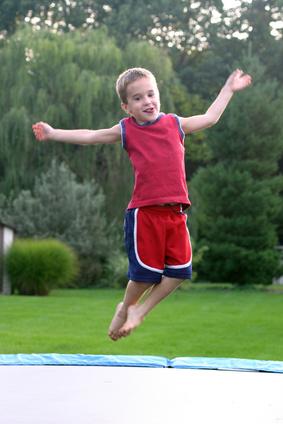It never fails. Children are attracted to whatever seems to be exciting and — sometimes — dangerous. Trampolines are no exception. The best course of action regarding the use of trampolines is that children only use them in supervised training programs, such as gymnastics classes. But, trampolines are for sale for backyard use. So if you do give in to the request, be as safe as possible.
High-Risk Activity
Jumping on a trampoline is a high-risk activity, according to MayoClinic.com. Your child could wind up with all sorts of fractures, sprains or strains. The potential also exists for serious head and neck injuries causing paralysis and even death. The American Academy of Pediatrics supports a ban on trampolines because of the high rate of injuries and because safety recommendations are rarely followed.
Cause of Injuries
The cause of injuries and death are from kids colliding with each other on the trampoline, landing the wrong way while doing stunts or jumping, falling off the trampoline or falling on the springs or frame of the trampoline. Even when children use trampolines properly, they can still get injuries by landing improperly, according to ConsumerReports.org.
Take Precautions
The Consumer Product Safety Commission recommends you take precautions if you have a trampoline. Only allow one person on the trampoline at a time. Forbid somersaults because a wrong landing on the head or neck could cause paralysis. Cover the springs and frame with shock-absorbing pads. Keep the trampoline in a wide, open space, away from trees or buildings. Supervise children on the trampoline. Child under 6 years of age should not use a full-size trampoline at all. Consider a trampoline enclosure to prevent falling off the trampoline. Never include a ladder for easy access onto the trampoline. That encourages children who are too young to use it.
Increase in Injuries
Despite the warnings that have been in effect to consumers since 1999, injuries are on the increase, as of 2010. Visits to the emergency room from trampoline accidents increased from 89,360 in 2002 to 107,435 in 2007, according to ConsumerReports.org. Speculation from ConsumerReports.org as to why injuries are up even after warnings and safety features are installed is that the safety features, such as net enclosures or shock-absorbing pads, don’t work, were not installed as parents claim at the hospital, or the safety features have fallen apart.
Stand Firm
You may be unpopular or even considered overprotective for not allowing a trampoline at your house. But, if you are uncomfortable with your kids on a trampoline, say “No.” Not only does the American Academy of Pediatrics recommend you not have a trampoline, ConsumerReports.org also advises against buying one. In addition, your homeowners insurance might go up if you purchase a trampoline.





